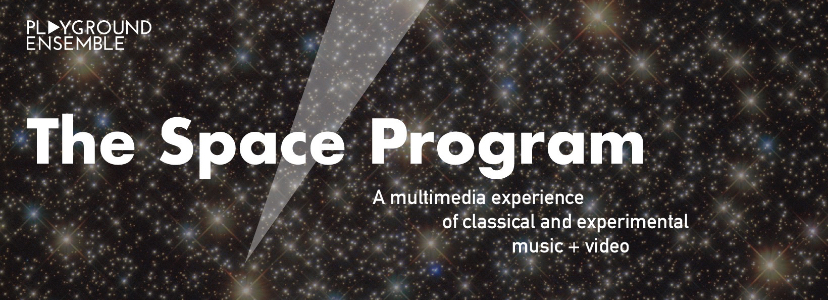
(Courtesy of The Playground Ensemble)
Bathed in eerie blue light, a vocalist intoned �La luna est� muerta� (�the moon is dead�), striking tiny finger cymbals. A flutist replied, �But is reborn in the springtime,� in Spanish, whispering over her mouthpiece. In the background, a warbly banjo, bongo drums and�a plucked cello traded a wandering motif. �
This song, �Night of the Four Moons� by George Crumb appeared midway through the Boulder Public Library�s Tuesday Lunchtime Concert Series on Tuesday. The concert, entitled �The Space Program,� featured Playground Ensemble, a Denver-based contemporary music group, playing space-themed music with psychedelic cosmic videos. The program also included a new commission, “Through Hardships We Become Stars,” by Conrad Kehn and Nicole Esquibel, as well as works by Monica Bolles, Annie Gosfield, Denver-based composer Nathan Hall and elementary schooler Aubrie McFadden.�
Like much experimental music, this performance pushed the boundaries of music versus sound. Traditional notions of music disappeared, leaving tonal chaos of fragmented melodies and ambient sounds, a mix of pre-recorded tracks and live extended techniques. Often, music like this feels inaccessible at first. Yet, once the composer�s intention begins to emerge, we learn to recalibrate our ear and accept that the music will never be what we expect. �
The space-themed music focused on ebb and flow of tension, letting the music breathe, finding ease in minimalism. During the opening song �Collision,� which is about black holes interacting, the violin screeched and the cello growled ominously, later using glissandos for engine-like effects and bouncy bow tapping for mysterious space clangs. Creating a science fiction experience, the music often felt like a soundtrack from Star Trek, Star Wars or Babylon 5. It wouldn�t have been surprising if Star Trek�s �Scotty� suddenly appeared to fix the glissando engine sounds, or if an Ewok ran onstage, echoing the cello�s growling noises.�
Meanwhile, trippy videos behind the performers took the audience through the universe, as if viewing space from Starship Enterprise�s bridge. Intended for a planetarium, the videos, however, didn�t fit well on the library�s rectangular screen. Space�s vastness could not be captured in a squished, two-dimensional circle.
Despite the technical constraints, the videos were enthralling. During �Collision,� red and blue circles pulsed in and out of each other, creating a mesmerizing metamorphosis. In �Lost Signals and Drifting Satellites,� fiery clouds of gas melted into each other, apricot, ochre, burnt orange and amber hues fusing, then cooling into peaceful azure, lilac and lime flames. A star exploded. Luminescent dust sprinkled across the screen, fast like firecrackers, speeding into blurry shooting stars. Traveling through the universe at light speed, an alien entity appeared, filled with an olive green neuron-like web.�
�The Space Program� looks to the future, innovatively using immersive multimedia. At first jarring and novel, the contemporary music later settled into the ear, aided by the magnificence of space.
Playground Ensemble will perform �The Space Program� again in Fort Collins this Thursday. More information can be found here.�
Contact CU Independent Arts Writer Isabella Fincher at isabella.fincher@colorado.edu.
